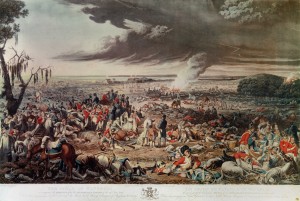The butcher’s bill
Published in
Uncategorized

The Field of Waterloo as it Appeared the Morning after the Memorable Battle of the 18th June 1815, coloured aquatint by M. Dubourg, 1817, after John Heaviside. (National Army Museum, London/Bridgeman Images)
Waterloo was, as Wellington described it afterwards, a battle fought ‘in the old style’. It took three days to collect the dead and wounded afterwards. The Anglo-Allied army had close to 3,000 dead (1,419 British), and the Prussians had 1,200 dead. The figure for those wounded was considerably larger, closer to 28%. Over half the officers were killed or wounded. French casualties are harder to calculate but are estimated at between 25,000 and 30,000 dead and wounded. It was perhaps no wonder that Wellington admitted on the evening of the battle that his heart was ‘broken by the terrible loss’ he had sustained, and that ‘next to a battle lost the greatest misery is a battle gained’.

















